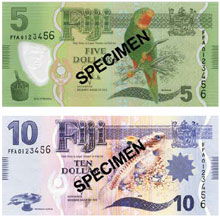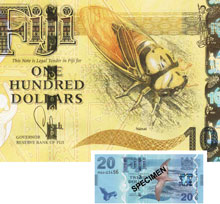Currency Notes
The Bug Bill

Fiji pays tribute to its rich animal and plant life
Nanai are a rare sight: the cicadas make an appearance in Fiji only once every eight years. The shiny-backed, yellowish tree bugs, a native of Viti Levu, Fiji’s largest and main island, also recently replaced the image of Queen Elizabeth II on the Fijian $100 banknote.
In 2012, Fiji decided to highlight its endemic national heritage—and the need to preserve, protect, and promote it—on the faces of its legal tender. The island nation in the South Pacific is not the first country to showcase its plants and animals on its currency. South Africa, New Zealand, and Brazil also flaunt species of elephants, falcons, and dusky groupers that are unique to their countries. In Fiji’s case, a number of these flora and fauna are critically endangered or have not been sighted in a long while.
Take, for example, the kulawai, or red-throated lorikeet, the smallest member of the parrot family in Fiji. Recorded on only four of the country’s 332 islands, the predominantly green bird with orange and yellow patches around its beak and tail was last seen in 1993 and is suspected to have fallen prey to an invasive species of ship rats. The bird, now likely extinct, is immortalized on Fiji’s only polymer banknote, the $5 bill.
The $10 banknote features a beli, or Lever’s goby, a freshwater fish found in fast-running streams in the highlands of Fiji. The $20 banknote depicts a bird that nests on a single island, Gau, which gave the otherwise seafaring Fiji petrel its name, kacau ni Gau. Experts believe that no more than 50 pairs of this rarely seen bird—which used to adorn Fiji’s former national airline, Air Pacific—survive today.
In addition to the banknotes, the Reserve Bank of Fiji issued a series of coins featuring other endemic species, including a rabbitfish, a flying fox, a parrot, a humphead wrasse, an iguana, and a peregrine falcon.
The only plant that made it onto the new tender is the tagimoucia, Fiji’s best-known flower, which flourishes only on a single island. “People have tried to plant it elsewhere in Fiji, but it refuses to grow,” said Susan Kumar, chief manager of the Currency and Corporate Services Group at the Reserve Bank of Fiji, who worked on the new banknote series from its conception to its launch in 2012.

“By using animals and plants unique to the Fiji Islands we wanted to make people aware of them, to help preserve them for the next generations,” she said. “Before, no one talked about the emergence of the nanai, for example. There were newspaper articles when these tree bugs reappeared last year.”
The choice of what to display on the banknotes and coins was made by a team of experts including biologists, historians of the National Museum of Fiji, and members from a cross section of the community. The committee, under the guidance of the former governor of the Reserve Bank, Barry Whiteside, quickly settled on the theme of flora and fauna, said Kumar. For her, the real excitement was seeing the designs emerge, some drawn from preserved specimens by Luis Morris, a former senior banknote designer at banknote manufacturer De La Rue, in the United Kingdom.
“Once I called him to follow up on something, and right at that moment he was busy doing the petals of the tagimoucia. He did not stop talking to me, but later showed me the petal he was drawing as we spoke. This memory is now etched in my mind and recalled every time I see the banknote,” she said.
The public loves the new design series, Kumar said. “The banknotes are colorful and vibrant, and people can relate to what they see on both the bills and the coins. It is the natural history of their country.” With the proud display of local natural riches, however, came a big change: after 78 years, the currency of the Commonwealth member country ceased to display images of the British royal family.
The collection of Fijian flora and fauna banknotes won the Regional Banknote of the Year Award in 2013 for its visual artistry, technical sophistication, and accurate reflection of the country’s cultural heritage.
PHOTOS: RESERVE BANK OF FIJI
Opinions expressed in articles and other materials are those of the authors; they do not necessarily reflect IMF policy.








